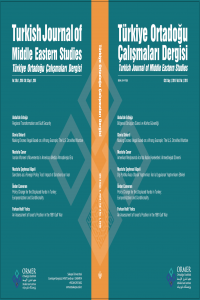Book Review
Year 2016,
Volume: 3 Issue: 1, 197 - 201, 15.10.2016
Abstract
2014 yılında Kolombiya University Press tarafından yayınlanan bu kitapta, en üst düzeydeki Ortadoğu uzmanlarının Arap ayaklanmaları ortaya çıkmasını, dinamiklerini, aktörlerini ve geleceğini açıklamak için ortay koyduğu eserler yer almaktadır.
References
- Philipp O. Amour, “Editor’s Note: The End of the Arab Spring?,” in The Arab Spring: Comparative Perspectives and Regional Implications, ed. Philipp O. Amour, vol. 12, no. 3, Special Issue, Alternatives: Turkish Journal of International Relations (Yalova: Yalova University Press, 2013), I–IV.
- Michelle Pace & Francesco Cavatorta (2012) The Arab Uprisings in Theoretical Perspective – An Introduction, Mediterranean Politics, 17:2, 125-138, DOI: 10.1080/13629395.2012.694040.
- Hafez Ghanem (2016). Roots of the Arab Spring, In The Arab Spring Five Years Later: Toward Great Inclusiveness (pp. 39-64). Brookings Institution Press. Retrieved from http://www.jstor.org/stable/10.7864/j.ctt1657tv8.6
- Philipp O. Amour, “Israel, the Arab Spring, and the Unfolding Regional Order in the Middle East: A Strategic Assessment,” British Journal of Middle Eastern Studies, 2016, doi:10.1080/13530194.2016.1185696.
- Hillel Frisch (2013) The Egyptian Army and Egypt's ‘Spring’, Journal of Strategic Studies, 36:2, 180-204, DOI: 10.1080/01402390.2012.740659.
- Paola Abenante (2014) Tahrir as Heterotopia: Spaces and Aesthetics of the Egyptian Revolution. In Fosshagen K. (Ed.), Arab Spring: Uprisings, Powers, Interventions, (pp. 21-32). Berghahn Books. Retrieved from http://www.jstor.org/stable/j.ctt9qchx9.4.
- Jamie Allinson (2015) Class forces, transition and the Arab uprisings: a comparison of Tunisia, Egypt and Syria, Democratization, 22:2, 294-314, DOI: 10.1080/13510347.2015.1010812.
- Ellen Lust (2011) Missing the Third Wave: Islam, Institutions, and Democracy in the Middle East, Published online: 12 April 2011 , St Comp Int Dev (2011) 46:163–190 DOI 10.1007/s12116-011-9086-z
Year 2016,
Volume: 3 Issue: 1, 197 - 201, 15.10.2016
Abstract
Published by Colombia University
Press in 2014, this book presents works of the top Middle East political
scientists to explain the eruption, dynamics, actors, and future of the Arab
uprisings.
References
- Philipp O. Amour, “Editor’s Note: The End of the Arab Spring?,” in The Arab Spring: Comparative Perspectives and Regional Implications, ed. Philipp O. Amour, vol. 12, no. 3, Special Issue, Alternatives: Turkish Journal of International Relations (Yalova: Yalova University Press, 2013), I–IV.
- Michelle Pace & Francesco Cavatorta (2012) The Arab Uprisings in Theoretical Perspective – An Introduction, Mediterranean Politics, 17:2, 125-138, DOI: 10.1080/13629395.2012.694040.
- Hafez Ghanem (2016). Roots of the Arab Spring, In The Arab Spring Five Years Later: Toward Great Inclusiveness (pp. 39-64). Brookings Institution Press. Retrieved from http://www.jstor.org/stable/10.7864/j.ctt1657tv8.6
- Philipp O. Amour, “Israel, the Arab Spring, and the Unfolding Regional Order in the Middle East: A Strategic Assessment,” British Journal of Middle Eastern Studies, 2016, doi:10.1080/13530194.2016.1185696.
- Hillel Frisch (2013) The Egyptian Army and Egypt's ‘Spring’, Journal of Strategic Studies, 36:2, 180-204, DOI: 10.1080/01402390.2012.740659.
- Paola Abenante (2014) Tahrir as Heterotopia: Spaces and Aesthetics of the Egyptian Revolution. In Fosshagen K. (Ed.), Arab Spring: Uprisings, Powers, Interventions, (pp. 21-32). Berghahn Books. Retrieved from http://www.jstor.org/stable/j.ctt9qchx9.4.
- Jamie Allinson (2015) Class forces, transition and the Arab uprisings: a comparison of Tunisia, Egypt and Syria, Democratization, 22:2, 294-314, DOI: 10.1080/13510347.2015.1010812.
- Ellen Lust (2011) Missing the Third Wave: Islam, Institutions, and Democracy in the Middle East, Published online: 12 April 2011 , St Comp Int Dev (2011) 46:163–190 DOI 10.1007/s12116-011-9086-z
There are 8 citations in total.
Details
| Journal Section | Book Review |
|---|---|
| Authors | |
| Publication Date | October 15, 2016 |
| Published in Issue | Year 2016 Volume: 3 Issue: 1 |
The published articles in TJMES are licensed under a
Creative Commons Attribution-NonCommercial 4.0 International License



